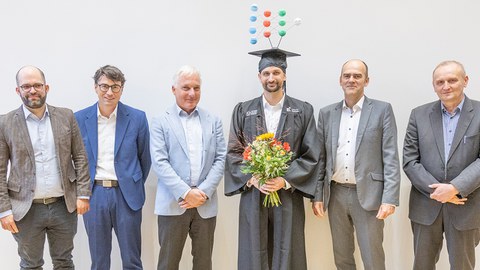Oct 14, 2025
Promotion Frederik Wedel

Frederik Wedel and the doctoral committee present
On 10.10.2025, Mr. Frederik Wedel, M.Sc., successfully defended his scientific work as part of the doctoral procedure 👨🎓 with the topic "Detection of structural changes in bridges
using machine learning methods". In addition to the chairman of the doctoral committee, Prof. Dr. Karsten Menzel (TU Dresden), Prof. Dr. Steffen Marx (TU Dresden), Prof. Dr. Karsten Geißler (TU Berlin) and Prof. Dr. Thomas Braml (Universität der Bundeswehr München) were present as reviewers. Prof. Dr. Robert Jockwer (TU Dresden) was also present as a member of the doctoral committee.
Abstract:
The increasing number of ageing bridge structures and the associated necessity to ensure their safety and longevity require automated monitoring systems. Structural anomalies must be detected at an early stage to allow timely interventions and prevent critical damage. Although numerous methods for anomaly detection exist in research, their transfer to practical applications remains limited. These approaches are often tested on laboratory or simulated data, whose applicability to real-world conditions is uncertain.
In this study, a regression-based method is applied to real measurement data, and its practical applicability is examined. The method was deliberately chosen because it utilizes long-term monitoring data, which are commonly collected at bridges where monitoring is conducted and are therefore available without additional measurement effort. This study is based on data from real structures where documented structural changes have been recorded. The method relies on predicting structural responses from temperature measurements using machine learning models. Differences between predicted and measured data are interpreted as anomalies. The Peak-Over-Threshold method is used for robust threshold determination to make reliable statements about the presence of structural changes. The results demonstrate that the method performs reliably under practical conditions and provides robust predictions. Systematic investigations of the necessary training parameters enabled an effective and early application of the method. Additionally, practice-oriented recommendations were developed to further enhance the robustness and transferability of the method. A key aspect is that the method can detect structural anomalies at an early stage while being flexible in its application to different structural types and challenges. It is suitable for both reinforced prestressed concrete and composite structures and can model linear relationships as well as nonlinear behaviors, such as temperature-induced bearing movement. The method does not rely on complex physical assumptions, significantly facilitating its practical applicability.
The conducted investigations show that the Multi-Layer Perceptron (MLP) regressor is the most effective model for predicting structural responses. It is lightweight and quick to train, enabling precise modeling of both linear and nonlinear relationships with high efficiency and robustness against overfitting.
Another major scientific contribution lies in the differentiation between measurement fault detection and structural anomaly detection. While correlated structural responses are used as input data to detect sensor faults or calibration issues, only external loads such as temperature are considered for the detection of structural changes. This ensures that structural changes are not masked by correlations within the input data.
Furthermore, applying the method requires engineering expertise in several key areas. First, careful data selection is necessary to choose appropriate input variables for modeling structural responses and to ensure that relevant influencing factors are properly considered. Feature engineering is also critical, involving the identification and processing of relevant features, particularly for capturing transient processes that affect structural behavior. Additionally, result interpretation plays a crucial role, as detected anomalies must be carefully assessed regarding their causes. Especially in distinguishing between measurement faults and actual structural changes. Thus, the method is not designed to be applied without critical evaluation but should always be used in the context of engineering assumptions and domain knowledge.
Moreover, the method can be applied under favorable conditions after just four months of measurement data. However, findings indicate that a longer period of six to nine months, ideally one year, leads to more robust results, as it ensures greater variability in the training data.
Additionally, it was observed that structural changes occurring within the training period have an almost linear effect on model performance. This means that models trained primarily on data from before a structural change tend to reflect the original structural behavior more strongly, whereas models trained on data after the change better capture the new structural behavior. This highlights the importance of carefully selecting the training period when applying data-driven methods in structural health monitoring.
Overall, this study contributes to the development of a practically applicable and robust method for monitoring structural behavior using machine learning.
Dear Frederik, we wish you every success in your future scientific career and, of course, all the best for your future! 👍🥳
